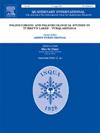Historical environmental change has increased disastrous flooding in Italy's northwestern Apennines (1511–2021 CE)
IF 1.9
3区 地球科学
Q3 GEOGRAPHY, PHYSICAL
引用次数: 0
Abstract
Damaging hydrological events can profoundly impact societies. This study reconstructs the longest flood history to date for the Orba River Basin (ORB) in northwestern Italy, from 1511 to 2021 CE. Using the Annual Flood Damage Index, we establish a continuous annual hydrological time-series. Our analysis, incorporating a seasonally-weighted function for interannual storm effects, uncovers anthropogenic influences on the ORB's fluvial landscape and flood characteristics. Specifically, a change-point emerged around the end of the Little Ice Age and the subsequent warming period (c. 1816), after which more intense storms prevailed. Remarkably, recent flood peaks align with heightened climate hazards, proving more extreme and unpredictable on a small scale in disaster-prone areas. Additionally, this study acknowledges competitive forcing factors on a larger scale, including landscape changes due to peasant civilisation expansion and 19th-century deforestation. Broader-scale factors, exemplified by the global impact of the 1815 eruption of Tambora in Indonesia, may have influenced the post-1816 climate conditions. These results emphasise the importance of considering both human-induced disturbances and precipitation occurrences in comprehending a territory's environmental history.

历史环境变化加剧了意大利西北部亚平宁山脉的灾难性洪灾(公元 1511-2021 年)
破坏性水文事件会对社会产生深远影响。本研究重建了意大利西北部奥尔巴河流域(ORB)从公元 1511 年到 2021 年迄今最长的洪水历史。我们利用年度洪水损失指数建立了连续的年度水文时间序列。我们的分析结合了季节性加权函数对年际风暴效应的影响,揭示了人为因素对 ORB 河流景观和洪水特征的影响。具体来说,在小冰河时期结束以及随后的气候变暖期(约 1816 年)前后出现了一个变化点,此后,更强烈的风暴盛行。值得注意的是,最近的洪水高峰与气候灾害的加剧相吻合,在灾害易发地区的小范围内,洪水变得更加极端和不可预测。此外,这项研究还确认了更大规模的竞争性影响因素,包括农民文明扩张和 19 世纪森林砍伐造成的景观变化。1815 年印度尼西亚坦博拉火山爆发对全球的影响等更大范围的因素也可能影响了 1816 年后的气候条件。这些结果表明,在理解一个地区的环境历史时,同时考虑人为干扰和降水现象非常重要。
本文章由计算机程序翻译,如有差异,请以英文原文为准。
求助全文
约1分钟内获得全文
求助全文
来源期刊

Quaternary International
地学-地球科学综合
CiteScore
5.60
自引率
4.50%
发文量
336
审稿时长
3 months
期刊介绍:
Quaternary International is the official journal of the International Union for Quaternary Research. The objectives are to publish a high quality scientific journal under the auspices of the premier Quaternary association that reflects the interdisciplinary nature of INQUA and records recent advances in Quaternary science that appeal to a wide audience.
This series will encompass all the full spectrum of the physical and natural sciences that are commonly employed in solving Quaternary problems. The policy is to publish peer refereed collected research papers from symposia, workshops and meetings sponsored by INQUA. In addition, other organizations may request publication of their collected works pertaining to the Quaternary.
 求助内容:
求助内容: 应助结果提醒方式:
应助结果提醒方式:


